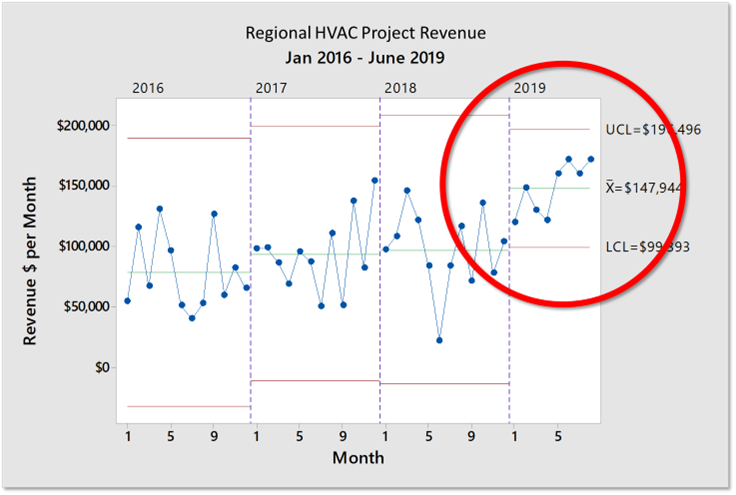A Repeatable Approach to Sales Process Design Increases Sales Productivity 40% in Six Months Case Study
Background
A European supplier of HVAC equipment to OEMs had grown to nearly €1 billion. However, their product managers were challenged to manage expectations and meet growth forecasts for various product lines due to differing languages and cultures around the globe.
Two challenges stood out. First, the firm had been trying to penetrate a new market – the building trades – for a decade with little success. Second, a cross-functional team had attempted to standardize everyone around a global sales process by setting up a CRM. Unfortunately, the effort of using the CRM generated much resistance from sales employees. This was especially true among the building trades sales team, where the main “OEM” oriented sales process didn’t seem to fit.
The European headquarters decided SPC, Inc. should assist a US-based team in developing a B2B sales process for its building trades market. The strategy was to pilot development of the new process in a single local sales office, and once proven, roll it out to others over time. Key goals were:
- Dramatically accelerated growth rates
- Sustainable, predictable, and measurable improvement
- PDSA-style continuous improvement approach
Client Discovery and Root Cause Analysis
A root cause of sales, marketing, and service challenges is their divergent views of the world. Therefore, the priority was for the team to fully understand the problem they were trying to solve. A guided discovery process revealed the team’s agreements and disagreements in this matter:
Disagreements
- What customers value
- What successful account relationships looked like
- What sales success looked like
- How to manage deal flow
Agreements
- Building trades differ from OEMs (multiple channels and customers)
- We do not know how to effectively learn what customers want
- We are not meeting customer expectations
- We do not know how to improve
Before Sales Process Excellence
Due to regional and structural differences in markets around the world, words like “prospect” and “qualified opportunity” meant widely different things to people. In addition, the salespeople had only a dotted line relationship to the Sales VP for building trades. Instead, they reported directly to OEM sales managers. The reasoning for this was that the salespeople were geographically closer to the OEM sales managers, so they could provide “hands-on” support when needed.
Unfortunately, these executives were preoccupied managing the larger OEM business, where marketing and product promotions created interest and inquiries. This was different from the building trades which require proactively calling on and building relationships with a wide variety of influencers in local markets over time. The differences produced conflict between the OEM and Building Trades executives.
Compensation had been tied to KPIs in the CRM. These KPIs were intended to encourage salespeople to spend more time on prospects who scored higher on a specific qualification framework. Unfortunately, the need to generate their own prospects meant the building trades salespeople had fewer opportunities to pursue. They could appear to be working hard only by completing large amounts of data entry in the CRM. No perceivable improvement in forecasts or close ratios took place. Managers struggled to identify KPIs that were more sales and marketing and customer oriented.
The SPE Approach
After achieving initial alignment around these challenges, the team proceeded through a repeatable sequence of work enabling them to design and test a new sales process. The VOC gathered VOC from both existing and new contacts uncovered surprising insights about the market.
- Identify VOC (including dealer channel customers)
“Our marketing touts our technology – but most of our customers couldn’t care less about it!” - Research and analyze niche market opportunities
“The biggest return for what we are good at is in the medical market, where the need is most urgent and the benefit most provable.” - Define observable quality attributes for
- Representative firms and dealers
“The best rep firms are those who already aim at the medical market.” - Strategic accounts
“Facilities engineers in large research hospitals are interested in the fact that we can reduce their infection rates.” - Sales opportunities
“Opportunities go through a predictable series of stages and dealers can help identify them.”
- Representative firms and dealers
- Develop Customer Value Maps
“We can identify what the main players want, how their performance is
measured, the strategies they employ, and the issues they struggle with.” - Testing sales activities and launching improvement cycles
“Once we have respectful agreement with our dealers on what we should all be looking for, prospects respond, and good news just starts happening!”
Results
The sales team generated their own sets of qualification and opportunity tracking tools, along with a cadence of sales meetings following the PDSA structure.
The new sales process required them to get prospects to talk freely about their business goals and challenges, a big difference compared to the old product-oriented way of selling. The team was excited to request and receive training and coaching for getting prospects to talk about their interests.
This improved the salespeople’s ability to build trusting, coaching relationships everywhere they went. The cadence of PDSA meetings drove numerous insights and ideas for improving.
In the first six months of applying the new process, the team’s average (mean) monthly revenue increased 45% per month. Variability in revenue (range) declined by 42%.
Enthusiasm for the new process was infectious. Other sales offices in North America requested to roll out the new approach as soon as possible.


